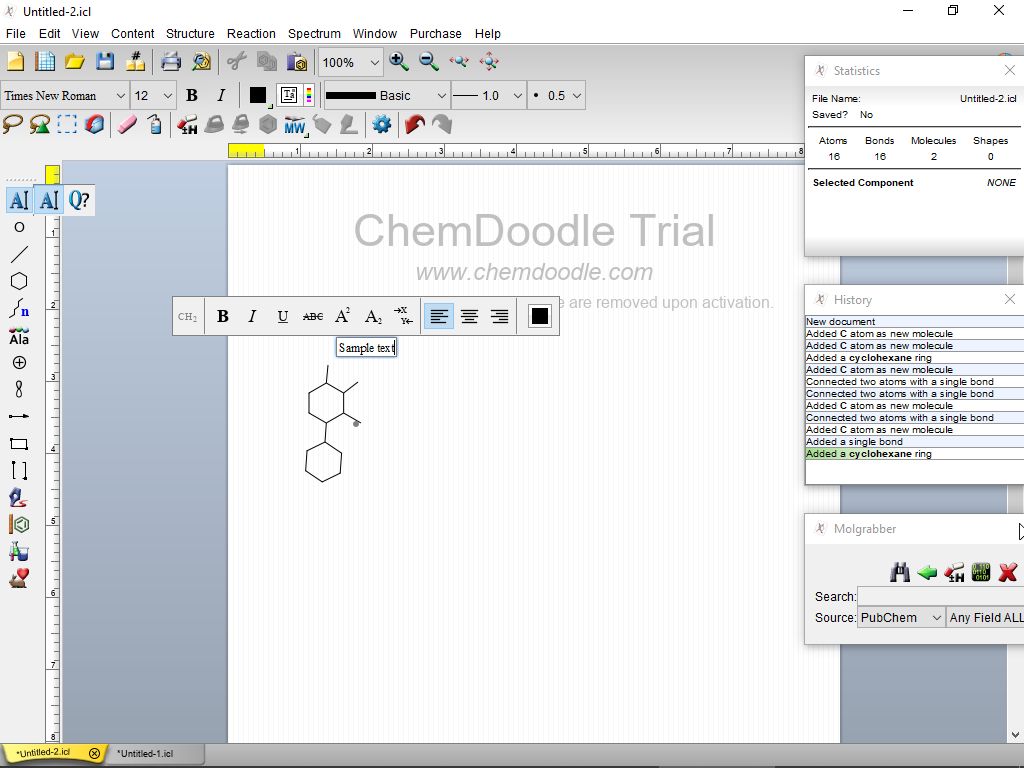
- #Chemdoodle formal numbers manual#
- #Chemdoodle formal numbers software#
- #Chemdoodle formal numbers code#
sy2), Tripos Sybyl Line Notation (.sln), Beilstein ROSDAL (.ros), XYZ Files (. mmod), Schrödinger Maestro (.mae), Standard Molecular Data (.smd), Tripos Mol2 (.mol2.


ent), RCSB Protein Data Bank Markup Language (.xml. mmcif), RCSB MacroMolecular Transmission Format (.mmtf), RCSB Protein Data Bank Files (.pdb. It is reliable and is used by thousands of institutions in many countries worldwide.
#Chemdoodle formal numbers software#
The software is compatible with multiple platforms such as Microsoft Windows, macOS, and Linux. rd), MDL RXNFiles, both V2000 and V3000 connection tables (.rxn), MMI SketchEl Molecule (.el), Molinspiration JME String (.jme), RCSB Binar圜IF (.bcif), RCSB Macromolecular Crystallographic Information File (.cif. ChemDoodle is a prominent and feature-rich 2D Chemical Drawing, Informatics, and Publishing solution that delivers premium quality at an affordable price. dx), ISIS Sketch File (.skc), ISIS Sketch Transportable Graphics File (.tgf), MDL MOLFiles, both V2000 and V3000 connection tables (.mol. smiles), IUPAC InChI (.inchi), IUPAC JCAMP-DX (.jdx. Read and write many popular chemical file types for working with the applications you use:ĪCD/ChemSketch Documents (.sk2), ChemDoodle Documents (.icl), ChemDoodle 3D Scenes (.ic3), ChemDoodle Javascript Data (.cwc.js), CambridgeSoft ChemDraw Exchange (.cdx), CambridgeSoft ChemDraw XML (.cdxml), Crystallographic Information Format (.cif), CHARMM CARD File (.crd), ChemAxon Marvin Document (.mrv), Chemical Markup Language (.cml), Daylight SMILES (.smi. Algorithmic Analysis of Cahn−Ingold−Prelog Rules of Stereochemistry: Proposals for Revised Rules and a Guide for Machine Implementation. and is 100% accurate in all 300 test cases provided. The CIP algorithm in ChemDoodle is validated against the test suite provided by Hanson et. Stereochemical features in your structures will be assigned "R", "S", "E", "Z", "M" and "P" descriptors. to remove any ambiguities and describe a completely consistent system for CIP assignments.ĬhemDoodle implements all 6 current CIP rules as well as auxilliary desciptors and mancude ring support. The most recent CIP rules from IUPAC were then algorithmically analyzed and standarized by Hanson et al. These rules were adopted by IUPAC for naming standards and fully described in the Blue books. While flawed, they have seen many revisions over the decades and were clarified by the work of Paulina Mata. You may define a personalized style file as well.The CIP rules have long been the standard for describing configurations of stereochemical features in a molecule. Or the systematic color scheme used in Kurti / Czako «Strategic Applications of Named Reactions in Organic Synthesis» ( a review) to guide the reader about reagents, bonds formed, etc. Of course you may use these standards even if you don't publish now in these.Įqually, working groups may have, sometimes inherited / influenced from the PI's time as a post-doc, their style adjusted bond widths, fonts, colors. differ from Synthesis, or Helvetica Chimica Acta, or RSC). Journals have their style sheets (e.g., JACS & Org. Often, it is a matter of style, litteraly. Subsequently, you may finalize drawing and exporting the image as. mol2 format is a widely understood format, you could build the molecules in question with the SMILES string from a database in one program, and save the intermediate in this format. You equally may use more than one program, too. Then, test them with own examples, draw the same molecules with either of them to spot similarities and differences.
#Chemdoodle formal numbers manual#
Chemdoodle's manual is more than 300 p., replicate Chemdraw tutorials like the ones by Pierre Morrieux / ChemdrawWizzard (e.g., here). Don't hesitate to test programs with a different philosophy than the mainstream ones (e.g., winplt) you may see in the working group across the aisle.įamiliarize yourself with the documentation of the software. Equally, it is helpful to test programs listed (e.g., here) for their improvment since last time of consultation. A side-by-side comparison (e.g., this one) may help for this. In no particular order of importance:įor one, it is a matter of knowing what the programs may offer and choosing your tools accordingly. Yes you can draw schemes like the one in your question with them.
#Chemdoodle formal numbers code#


siunitx for handling physical quantities (here, temperatures).chemmacros for the typesetting of chemical formulas and chemistry-related notations.chem fig for drawing 2D chemical structures (note that I enabled sans-serif font for the labels like the original did).I reproduced these reaction schemes with $\mathrm\LaTeX$ using the following particular packages:


 0 kommentar(er)
0 kommentar(er)
